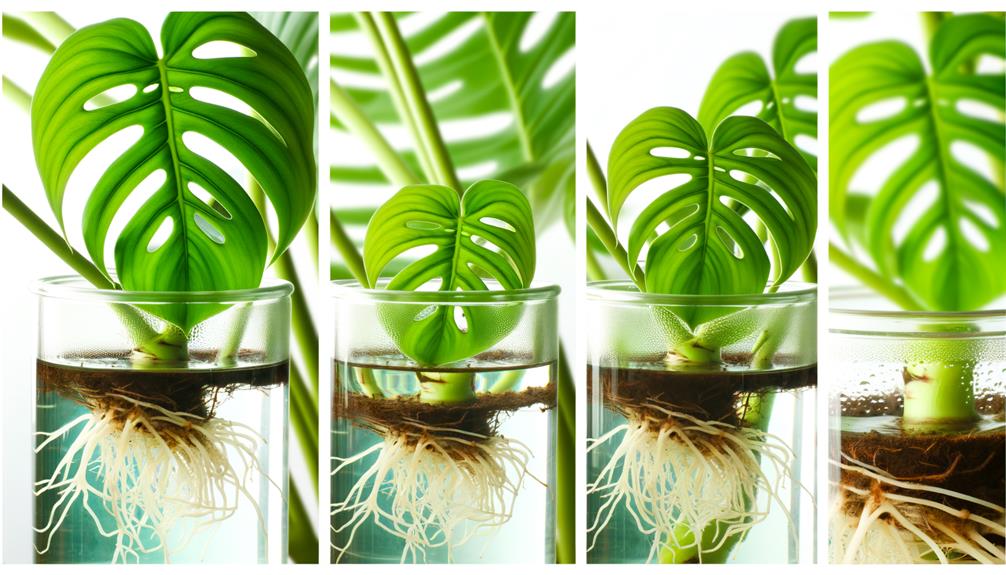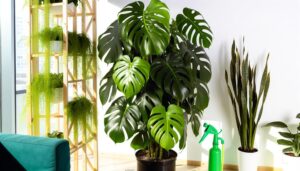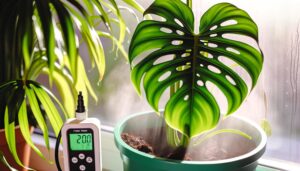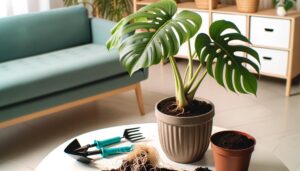Monstera Lechleriana Propagation
To propagate Monstera lechleriana, start with sterilized pruning shears and select a cutting with at least one healthy node and attached leaf. Apply rooting hormone (Indole-3-butyric acid) and plant in sphagnum moss or a well-draining potting mix.
Maintain high humidity using a propagation dome or plastic bag, and keep the temperature between 65-80°F. Ensure bright, indirect light and water when the top inch of soil dries.
Monitor for pests like spider mites and use insecticidal soap if necessary. With ideal conditions, you'll notice root development soon.
Explore more for advanced techniques and troubleshooting common issues.

Key Takeaways
- Select a 4-6 inch cutting with at least one healthy node and mature leaf.
- Use sterilized pruning shears and rooting hormone for optimal results.
- Place the cutting in well-draining soil or water, changing water every 3-5 days.
- Ensure high humidity (60-70%) and temperatures between 65-80°F.
- Provide bright, indirect light and water when the top inch of soil is dry.
Understanding Monstera Lechleriana
To truly understand Monstera lechleriana, you need to recognize its distinguishing characteristics, such as its deeply fenestrated leaves and robust growth habit. The species, belonging to the Araceae family, exhibits large, perforated leaves that can reach up to 60 cm in length. These fenestrations, or natural leaf holes, enhance light penetration to lower leaves, optimizing photosynthesis.
Monstera lechleriana displays a climbing growth habit, utilizing aerial roots to attach to supports. Its internodes are relatively short, contributing to a dense foliage appearance. The plant thrives in high humidity and indirect light, mimicking its native tropical rainforest environment.
Understanding these specific traits is essential for successful cultivation and propagation, ensuring healthy growth and vibrant foliage.
Necessary Tools and Materials
Gathering the right tools and materials is important for the successful propagation of Monstera lechleriana, making sure each step is executed with precision and care.
You'll need sterilized pruning shears (Falco 2) to make clean cuts, which reduces the risk of infection. Obtain rooting hormone (Indole-3-butyric acid, IBA) to stimulate root growth.
A clean, sharp knife (X-Acto No. 1) is vital for dividing rhizomes. Use sphagnum moss (Sphagnum palustre) or a well-draining potting mix to provide an ideal rooting medium.
Transparent plastic bags or a propagation dome can maintain humidity levels. A spray bottle for misting and sanitized containers (plastic pots, 4 inches) are also necessary.
Don't forget gloves to protect your hands and promote cleanliness.
Choosing the Right Cutting
When choosing a cutting for Monstera lechleriana propagation, make sure you select a segment with at least one healthy node and an attached leaf.
The node, which contains meristematic tissue, is important for root development.
Aim for a cutting length of 4-6 inches to provide sufficient resources for successful growth.
Node and Leaf Selection
Selecting the optimal cutting for Monstera lechleriana propagation relies on identifying a healthy node, characterized by a small, protruding bump where roots and new growth emerge.
Inspect the stem for nodes that are firm, green, and free from damage or disease. Avoid nodes that appear brown or mushy, as they won't support new growth effectively.
Choose a cutting that includes at least one mature, healthy leaf. The leaf should be vibrant green, free from yellowing, spots, or tears, and exhibit strong turgor pressure, indicating optimum hydration.
Make sure the leaf isn't excessively large, as excessive leaf surface area can lead to increased transpiration, which stresses the cutting and reduces propagation success.
Ideal Cutting Length
To guarantee successful Monstera lechleriana propagation, cuttings should ideally measure between 4 to 6 inches in length, incorporating at least one node and one mature leaf. Make sure the node, the pivotal growth point for roots, is clearly visible and free from damage.
The leaf should be healthy, exhibiting a vibrant green hue without signs of disease or pest infestation. Utilize sterilized pruning shears to make a clean cut just below the node. This minimizes the risk of infection and promotes ideal root development.
Preparing the Cuttings
When preparing your Monstera lechleriana cuttings, start by selecting healthy stems with at least one node and aerial root.
Use sterilized pruning shears to make a clean cut just below the node, ensuring minimal damage to the plant tissue.
Immediately place the cuttings in water or a moist substrate to prevent dehydration and promote root initiation.
Selecting Healthy Stems
Healthy stems of Monstera lechleriana, identifiable by their vibrant green color and absence of disease or pests, are essential for successful propagation. You need to look for stems that are firm and free from discoloration.
Avoid any stems with signs of fungal infections, such as black spots or powdery mildew. Check for nodes, the small, knobby areas where leaves and roots grow; a healthy stem should have at least one visible node.
Examine the leaves attached to the stem; they should be lush and free from yellowing or browning edges. By selecting stems that exhibit these characteristics, you increase the likelihood of successful rooting and growth, ensuring your Monstera lechleriana cuttings will thrive.
Proper Cutting Techniques
Ensuring precise cutting techniques for Monstera lechleriana involves using sterile, sharp pruning shears to make clean cuts just below a node. This method maximizes the plant's potential for successful propagation.
Here's a step-by-step guide to preparing the cuttings:
- Sterilize Tools: Use rubbing alcohol or a bleach solution to sterilize pruning shears, preventing pathogen transmission.
- Locate Nodes: Identify nodes, the swollen, knobby sections where leaves emerge and roots form—key for growth.
- Make the Cut: Position the shears just below a node, ensuring a swift, clean cut at a 45-degree angle to optimize rooting.
- Remove Excess Leaves: Trim leaves near the cut end to reduce moisture loss, leaving one or two for photosynthesis.
These steps enhance the health and success of your Monstera lechleriana propagation.
Water Propagation Method
To propagate Monstera lechleriana using the water method, start by selecting a healthy stem cutting with at least one node and a few aerial roots. Place the cutting in a transparent container filled with clean, dechlorinated water, making sure the node is fully submerged.
Position the container in indirect sunlight, as direct exposure can harm the cutting. Change the water every 3-5 days to prevent bacterial growth and ensure oxygenation. Within a few weeks, you'll notice root development.
Once roots are approximately 2-3 inches long, the cutting is ready for potting. Monitor for signs of root rot, such as browning or sliminess, and use sterilized tools to trim affected areas if needed.
Soil Propagation Method
For successful soil propagation of Monstera lechleriana, start with a well-draining soil mix composed of peat, perlite, and orchid bark.
Apply a rooting hormone like indole-3-butyric acid (IBA) to the cut ends to promote root development.
Maintain ideal moisture levels by watering the medium thoroughly, but make sure it doesn't become waterlogged.
Ideal Soil Mix
When propagating Monstera lechleriana through soil, it's important to create a well-draining mix composed of equal parts perlite, orchid bark, and high-grade potting soil to mimic their native tropical environment. This guarantees optimal aeration and moisture control, essential for Monstera's root development.
Begin by gathering your materials:
- Perlite (Perlita): Improves aeration and drainage.
- Orchid Bark (Cortex Orchidaceae): Provides organic material and retains moisture.
- High-grade potting soil (Solum hortensis): Provides necessary nutrients.
- Activated charcoal (Carbo activatus): Prevents root rot and absorbs contaminants.
Thoroughly mix these components to create a substrate that supports strong root growth. By ensuring the soil mix's correct composition, you promote a healthy environment suitable for Monstera lechleriana's vigorous propagation.
Rooting Hormone Use
Incorporating rooting hormone (Hormones radices) into your propagation process can greatly enhance the chances of successful root development in Monstera lechleriana cuttings. You'll want to use a powdered rooting hormone for ideal adherence.
Start by making a clean cut just below a node on a healthy stem section of Monstera lechleriana. Dip the cut end into the rooting hormone, ensuring it's evenly coated. Gently tap off any excess powder to avoid clumping.
Next, plant the treated cutting into a pre-moistened, well-draining soil mix, rich in organic matter. The rooting hormone stimulates auxin production, accelerating root cell differentiation and elongation.
This scientific method boosts root initiation, providing your Monstera lechleriana the best start for vigorous growth.
Watering and Moisture Levels
Maintaining ideal moisture levels in the soil is crucial for the successful propagation of Monstera lechleriana. You should make sure that the soil remains consistently moist but not waterlogged.
Here's a step-by-step guide to help you:
- Soil Composition: Use a well-draining mix with equal parts perlite (Perlitum), peat moss (Sphagnum), and orchid bark (Cortex Orchidaceae).
- Watering Frequency: Water the soil thoroughly when the top 1-2 inches (2.5-5 cm) feel dry to the touch.
- Humidity Control: Maintain ambient humidity around 60-70% to promote healthy root development.
- Drainage: Guarantee pots have adequate drainage holes to prevent water accumulation, which can lead to root rot (Phytophthora spp.).
Planting in Potting Mix
To successfully plant Monstera lechleriana in potting mix, make certain the substrate is a well-draining blend of peat moss, perlite, and orchid bark. Begin by mixing equal parts Sphagnum peat moss (Sphagnum spp.), horticultural perlite (volcanic glass), and orchid bark (fir bark). This combination guarantees adequate aeration and moisture retention, preventing root rot.
Place the plant cutting, making sure the node is buried in the mix. Firmly press the substrate around the cutting to eliminate air pockets. Water the mix lightly until it's uniformly moist but not soggy. Choose a container with drainage holes to avoid waterlogging.
Providing Optimal Conditions
Maintaining Monstera lechleriana's thriving condition involves keeping a consistent temperature range of 65-80°F (18-27°C) and providing indirect, bright light to mimic its natural rainforest habitat.
Guarantee humidity levels around 60-70%, as these plants thrive in moist environments. Water the Monstera lechleriana when the top inch of soil feels dry, using filtered water to prevent mineral buildup.
To create ideal conditions, consider the following:
- Humidity: Use a humidifier or place the plant on a pebble tray with water.
- Light: Position near east or north-facing windows to avoid direct sunlight.
- Temperature: Avoid placing near drafts or heating vents.
- Soil: Use well-draining potting mix rich in organic matter, such as peat moss and perlite.
Troubleshooting Common Issues
Identifying and addressing common issues with Monstera lechleriana guarantees your plant remains healthy and vibrant. Yellowing leaves often indicate overwatering or poor drainage. Confirm the soil mix is well-draining and reduce watering frequency. Brown leaf tips suggest low humidity; Monstera lechleriana thrives in 60-80% humidity. Use a humidifier or pebble tray to elevate levels. Pests like spider mites (Tetranychidae) and scale (Coccoidea) can infest your plant. Treat infestations with insecticidal soap or neem oil.
| Symptom | Cause | Solution |
|---|---|---|
| Yellowing Leaves | Overwatering | Improve drainage, reduce watering |
| Brown Leaf Tips | Low Humidity | Increase humidity |
| Leaf Drop | Insufficient Light | Provide bright, indirect light |
| Stunted Growth | Nutrient Deficiency | Fertilize appropriately |
| Pests | Spider Mites, Scale | Use insecticidal soap, neem oil |
Regularly inspect your plant to catch issues early.
Encouraging Root Growth
Promoting sturdy root growth in Monstera lechleriana involves using a well-aerated soil mix rich in organic matter, such as peat moss (Sphagnum) and perlite. This combination ensures best moisture retention and drainage, essential for healthy root development.
To enhance root growth, consider employing the following techniques:
- Rooting Hormones: Dip cuttings in auxin-based rooting hormones (IBA, NAA) to stimulate root initiation.
- Humidity Control: Maintain high humidity (70-80%) using a humidity dome or misting regularly.
- Consistent Moisture: Keep the soil consistently moist but not waterlogged to prevent root rot.
- Warm Environment: Position cuttings in a warm location (22-25°C) to accelerate metabolic processes.
These steps will provide the ideal conditions for your Monstera lechleriana to develop a strong root system.
Transplanting and Care
After your Monstera lechleriana cuttings have developed a robust root system, it's time to transplant them into individual pots for further growth and care.
Select a well-draining potting mix, rich in organic matter, to mimic their native tropical environment. Gently place each cutting into a pot, ensuring the roots are spread out evenly.
Water the soil thoroughly but avoid waterlogging to prevent root rot. Place the pots in a location with bright, indirect light, maintaining a humidity level of around 60-70%.
Fertilize monthly with a balanced, water-soluble fertilizer (20-20-20) during the growing season. Monitor for common pests like spider mites and aphids, and keep the leaves clean by wiping them with a damp cloth.
Conclusion
By following these propagation steps, you'll guarantee your Monstera lechleriana thrives. Utilizing proper equipment, selecting prime cuttings, and optimizing conditions will yield a robust, healthy plant.
Remember, occasional setbacks are just part of the learning curve. With patience and attention, you'll witness your Monstera lechleriana flourish, transforming your space into a verdant haven.
So, roll up your sleeves, embrace the journey, and soon, you'll be rewarded with a thriving, lush Monstera lechleriana.






